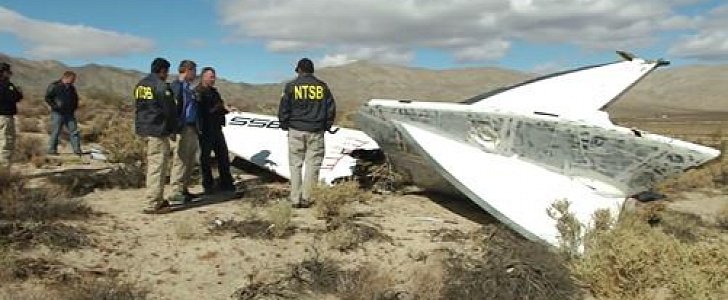As you may well remember, October last year found Virgin Galactic’s first SpaceShipTwo craft break up in-flight and crash in the Mojave desert. In the tragic event, one pilot was killed while the other treated for a severe shoulder injury after parachuting from 50,000 feet. The National Transportation Safety Board (NTSB) has finished the investigation and announced today what caused the crash.
The accident occurred during the program’s 55th overall and fourth powered test flight of SpaceShipTwo. At 10:07 PDT, the aircraft experienced a serious in-flight anomaly during a rocket-powered test flight approximately 13 seconds after release that resulted in the destruction of the vehicle and the death of the copilot.
What was supposed to be a promising first trip that would bring hope to both Sir Richard Bronson’s crew and the hundreds of customers who paid the tickets in advance, turned into a nightmare. Ever since the accident happened, everybody has been waiting for an official conclusion of the investigation. Earlier rumors appeared to show that the reason was a combination of co-pilot error, and inadequate safety procedures.
The results NTSB just released, unfortunately, seem to confirm the rumors. “The Probable Cause of this accident was the copilot’s unlocking of SpaceShipTwo’s feather locks at 0.92 Mach, approximately 14 seconds prior to the flight manual minimum speed of 1.4 Mach,” the Board shows in a press release.
At the time of the test, Scaled Composites, a wholly-owned subsidiary of the Northrop Grumman Corporation, was under contract with Virgin Galactic and The Spaceship Company to carry out the ship’s developmental flight test program. In other words, they handled maintaining both operational and safety oversight, NTSB also explains.
In terms of recommendations to Scaled Composites and Virgin Galactic, NTSB has created a list that includes the addition of a mechanical system that will prevent the feathering system from premature unlocking, and a change to the checklist and call-outs that the pilots must go through before unlocking that system. These changes and plenty of other advice have already been applied so we can only hope future tests will be safer.
The accident occurred during the program’s 55th overall and fourth powered test flight of SpaceShipTwo. At 10:07 PDT, the aircraft experienced a serious in-flight anomaly during a rocket-powered test flight approximately 13 seconds after release that resulted in the destruction of the vehicle and the death of the copilot.
What was supposed to be a promising first trip that would bring hope to both Sir Richard Bronson’s crew and the hundreds of customers who paid the tickets in advance, turned into a nightmare. Ever since the accident happened, everybody has been waiting for an official conclusion of the investigation. Earlier rumors appeared to show that the reason was a combination of co-pilot error, and inadequate safety procedures.
The results NTSB just released, unfortunately, seem to confirm the rumors. “The Probable Cause of this accident was the copilot’s unlocking of SpaceShipTwo’s feather locks at 0.92 Mach, approximately 14 seconds prior to the flight manual minimum speed of 1.4 Mach,” the Board shows in a press release.
At the time of the test, Scaled Composites, a wholly-owned subsidiary of the Northrop Grumman Corporation, was under contract with Virgin Galactic and The Spaceship Company to carry out the ship’s developmental flight test program. In other words, they handled maintaining both operational and safety oversight, NTSB also explains.
In terms of recommendations to Scaled Composites and Virgin Galactic, NTSB has created a list that includes the addition of a mechanical system that will prevent the feathering system from premature unlocking, and a change to the checklist and call-outs that the pilots must go through before unlocking that system. These changes and plenty of other advice have already been applied so we can only hope future tests will be safer.
